
Our next destination after visiting Kulen mountain was temple of Banteay Srei. Considered by many to be the jewel in the crown of Angkorian art, Banteay Srei is cut from stone of a pinkish hue and includes some of the finest stone carving anywhere on earth.

We had our lunch at one of the eatery next to the temple and started our exploration of the temple. It had rained a little earlier. Rain created an increase in humidity and caused pretty uncomfortable heat. Bright harsh light was another impediment to capture the wonderful hue which only the eyes could appreciate while the camera struggled to capture.
Banteay Srei is a 10th-century Cambodian temple dedicated to the Hindu god Shiva. Located in the area of Angkor in Cambodia. It lies near the hill of Phnom Dei, 25 km (16 mi) north-east of the main group of temples that once belonged to the medieval capitals of Yasodharapura and Angkor Thom.

Banteay Srei is built largely of red sandstone, a medium that lends itself to the elaborate decorative wall carvings which are still observable today. The buildings themselves are miniature in scale, when measured by the standards of Angkorian construction.

Banteay Srei is the modern name of a 10th-century Khmer temple originally called “Tribhuvanamahesvara” (Great Lord of the Threefold World). The temple’s modern name, Banteay Srei — “citadel of the women”, or “citadel of beauty” is probably related to the intricacy of the bas relief carvings found on the walls and the tiny dimensions of the buildings themselves. Some have speculated that it relates to the many devatas carved into the walls of the buildings.

Consecrated on 22 April 967 CE Banteay Srei was the only major temple at Angkor not built by a monarch; its construction is credited to the courtiers named Vishnukumara and Yajnavaraha. Yajnavaraha who served as a counsellor to king Rajendravarman II. The foundational stela says that Yajnavaraha, grandson of king Harsavarman I, was a scholar and philanthropist who helped those who suffered from illness, injustice, or poverty. His pupil was the future king Jayavarman V (r. 968- ca. 1001). Originally, the temple was surrounded by a town called Ishvarapura.

The temple was primarily dedicated to the Hindu god Shiva. However, the temple buildings appear to be divided along the central east-west axis between those buildings located south of the axis, which are devoted to Shiva, and those north of the axis, which are devoted to Vishnu.

Banteay Srei was subject to further expansion and rebuilding work in the eleventh century. At some point it came under the control of the king and had its original dedication changed. It might be the reason for the Vishnu related buildings. The temple being given to the priest Divaakarapandita (the courtier who helped to design Angkor Wat) and being rededicated to Shiva. It remained in use at least until the fourteenth century according to the last known inscription.
The temple was rediscovered only in 1914, and was the subject of a celebrated case of art theft when André Malraux, who stole four devatas in 1923 (he was soon arrested and the figures returned).
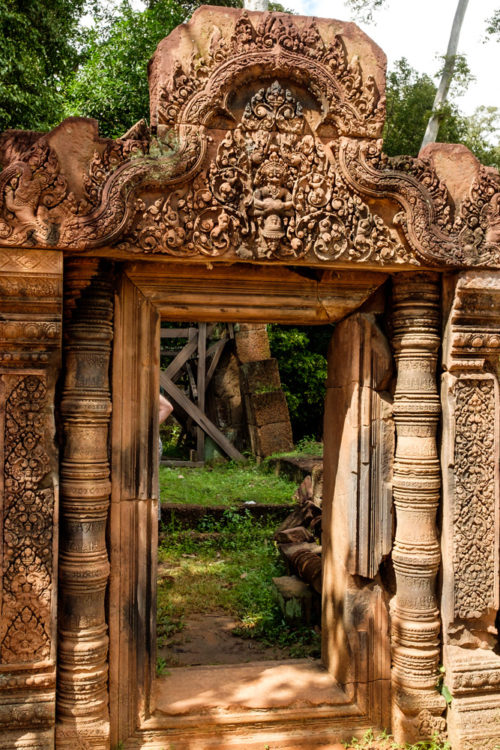
The incident stimulated interest in the site, which was cleared the following year, and in the 1930s Banteay Srei was restored through the first important use of anastylosis at Angkor whereby a ruined building or monument is restored using the original architectural elements to the greatest degree possible. Until the discovery of the foundation stela in 1936, it had been assumed that the extreme decoration indicated a later date than was in fact the case. To prevent the site from water damage, the joint Cambodian-Swiss Banteay Srei Conservation Project installed a drainage system between 2000 and 2003. Measures were also taken to prevent damage to the temples walls from nearby trees.


Unfortunately, the temple has been ravaged by pilfering and vandalism. When toward the end of the 20th century authorities removed some original statues and replaced them with concrete replicas, looters took to attacking the replicas. A statue of Maheshwara and his shakti Uma, removed to the National Museum in Phnom Penh for safekeeping, was assaulted in the museum itself.
Banteay Srei is built largely of a hard red sandstone that can be carved like wood. Brick and laterite were used only for the enclosure walls and some structural elements. The temple is known for the beauty of its sandstone lintels and pediments.
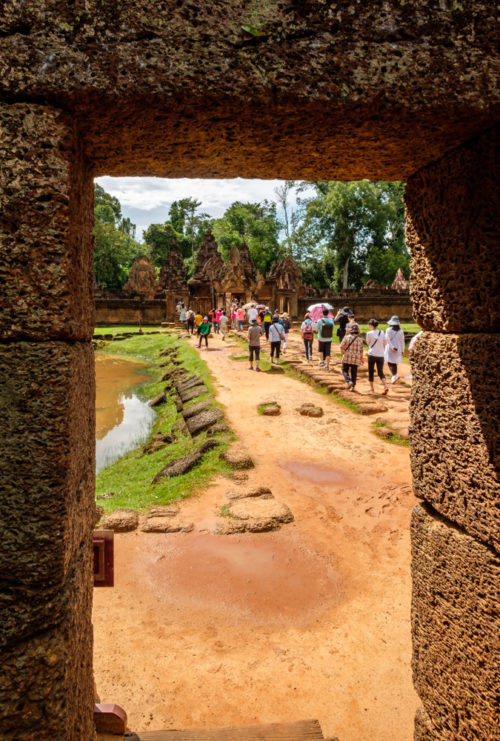
A pediment is the roughly triangular space above a rectangular doorway or openings. At Banteay Srei, pediments are relatively large in comparison to the openings below, and take a sweeping gabled shape. For the first time in the history of Khmer architecture, whole scenes of mythological subject-matter are depicted on the pediments.

A lintel is a horizontal beam spanning the gap between two posts. Some lintels serve a structural purpose, serving to support the weight of the superstructure, while others are purely decorative in purpose. The lintels at Banteay Srei are beautifully carved, rivalling those of the 9th century Preah Ko style in quality.

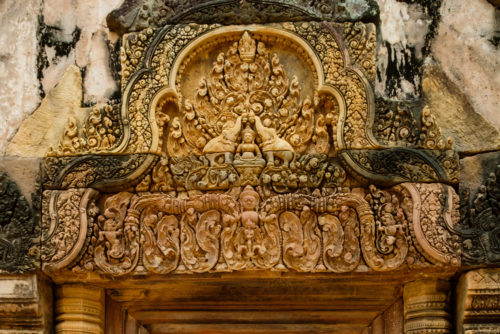

Noteworthy decorative motifs include the kala (a toothy monster symbolic of time), the guardian dvarapala (an armed protector of the temple) and devata (demi-goddess), the false door, and the colonette. Indeed, decorative carvings seem to cover almost every available surface.

The site consists of three concentric rectangular enclosures constructed on an east–west axis. A causeway situated on the axis leads from an outer gopura, or gate, to the third or outermost of the three enclosures. The inner enclosure contains the sanctuary, consisting of an entrance chamber and three towers, as well as two buildings conventionally referred to as libraries.


The gopura is all that remains of the outer wall surrounding the town of Ishwarapura. The wall is believed to have measured approximately 500 m square, and may have been constructed of wood. The gopura’s eastern pediment shows Indra, who was associated with that direction, mounted on his three-headed elephant Airavata. The 67 m causeway with the remains of corridors on either side connects the gopura with the third enclosure. North and south of this causeway are galleries with a north–south orientation.



The third enclosure is 95 by 110 m; it is surrounded by a laterite wall breached by gopuras at the eastern and western ends. Neither pediment of the eastern gopura is in situ. The east-facing pediment is lying on the ground. It depicts a scene from the Ramayana in which a demon seizes Rama’s wife Sita. Most of the area within the third enclosure is occupied by a moat divided into two parts by causeways to the east and west.



The second enclosure sits between an outer laterite wall measuring 38 by 42 m, with gopuras at the eastern and western ends, and a brick inner enclosure wall, measuring 24 by 24 m. The western gopura features an interesting bas relief depicting the duel of the monkey princes Vali and Sugriva, as well as Rama’s intervention on Sugriva’s behalf.


Between the gopuras on the collapsed inner wall are the buildings of the inner enclosure: a library in the south-east corner and another in the north-east corner, and in the centre the sanctuary set on a T-shaped platform 0.9 m high. Besides being the most extravagantly decorated parts of the temple, these have also been the most successfully restored (helped by the durability of their sandstone and their small scale). In 2010, the first enclosure is open to visitors again, but the inner temples are roped off and inaccessible.
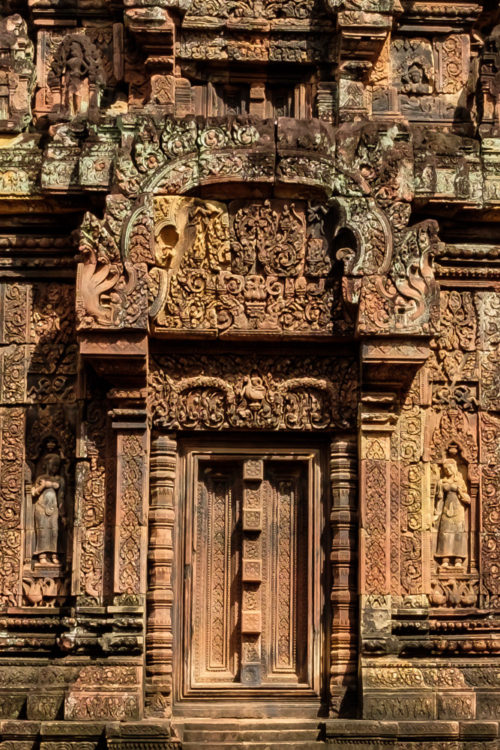

The east-facing pediment on the southern library shows Siva seated on the summit of Mount Kailasa, his mythological abode. His consort Uma sits on his lap and clings anxiously to his torso. Other beings are also present on the slopes of the mountain, arranged in a strict hierarchy of three tiers from top to bottom. In the top tier sit bearded wise men and ascetics, in the middle tier mythological figures with the heads of animals and the bodies of humans, and in the bottom tier large animals, including a number of lions. In the middle of the scene stands the ten-headed demon king Ravana. He is shaking the mountain in its very foundations as the animals flee from his presence and as the wise men and mythological beings discuss the situation or pray. According to the legend, Siva stopped Ravana from shaking the mountain by using his toe to press down on the mountain and to trap Ravana underneath for 1000 years.


The west-facing pediment on southern library shows Siva again seated on the summit of Mount Kailasa. He is looking to his left at the god of love Kama, who is aiming an arrow at him. Uma sits to Siva’s right; he is handing her a chain of beads. The slopes of the mountain are crowded with other beings, again arranged in a strict hierarchy from top to bottom. Just under Siva sits a group of bearded wise men and ascetics, under whom the second tier is occupied by the mythological beings with the heads of animals and the bodies of humans; the lowest tier belongs the common people, who mingle sociably with tame deer and a large gentle bull. According to the legend, Kama fired an arrow at Siva in order to cause Siva to take an interest in Uma. Siva, however, was greatly angered by this provocation, and punished Kama by gazing upon him with his third eye, frying Kama to cinders.
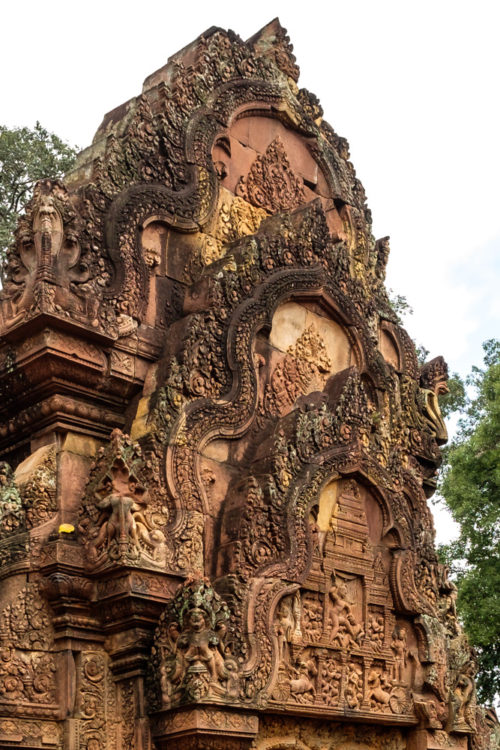


The east-facing pediment on the northern library shows the god of the sky Indra creating rain to put out a forest fire started by the god of fire Agni for purposes of killing the naga king Takshaka who lived in Khandava Forest. The Mahabharatan heroes Krishna and Arjuna are shown helping Agni by firing a dense hail of arrows to block Indra’s rain. Takshaka’s son Asvasena is depicted attempting to escape from the conflagration, while other animals stampede about in panic.
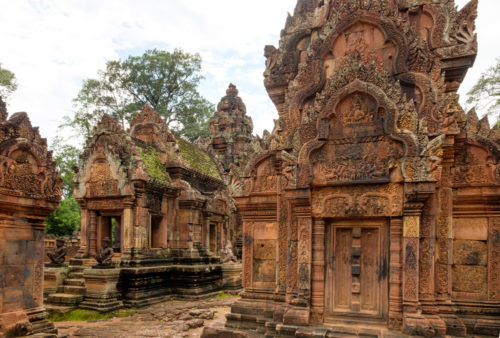
The sanctuary is entered from the east by a doorway only 1.08 m in height: inside is an entrance chamber (or mantapa) with a corbelled brick roof, then a short corridor leading to three towers to the west: the central tower is the tallest, at 9.8 m. The impression of delicacy given the towers by the antefixes on each of their tiers. The six stairways leading up to the platform were each guarded by two kneeling statues of human figures with animal heads; most of those now in place are replicas, the originals having been stolen or removed to museums.

Banteay Srei is about 32km northeast of Siem Reap and 21km northeast of Bayon. From Siem Reap should take about one hour by Tuk Tuk. Drivers will want a bit of extra cash to come out here, so agree on a sum first. You can eat at one of several small restaurants, complete with ornate wood furnishings cut from Cambodia’s forests, near the entrance to the temple.
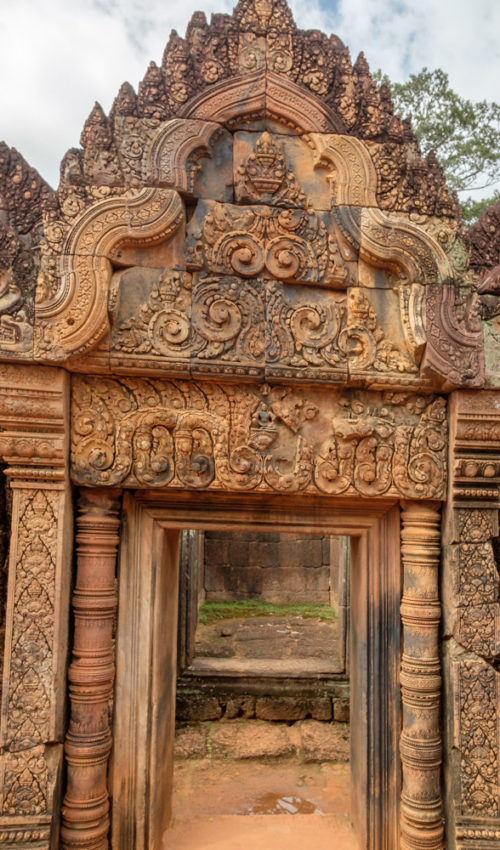
It takes 45 minutes to explore Banteay Srei temple, but allow 90 minutes to visit the information centre and explore the area. Early morning or late evening are the best period to explore this beautiful templeCheck this wonderful documentary in 7 parts on Banteay Srei.

Our next stop was the Cambodian Landmine Museum and Relief Facility. It is a museum located south of the Banteay Srey Temple complex, 25 kilometers north of Siem Reap, and inside the Angkor National Park.
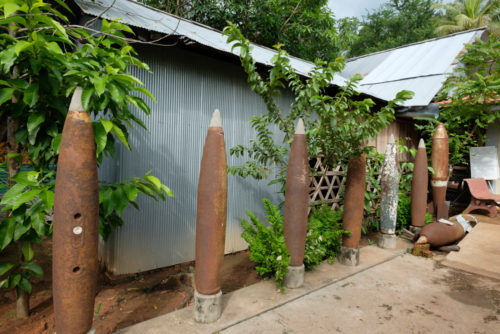
Aki Ra was just 10 years old when the Khmer Rouge took him in hand and taught him how to lay landmines. A few years later, the Vietnamese put him to work too. Thanks to them, and the Cambodian government, Cambodia’s border with Thailand is, in places, one of the deadliest in the world. Once the war was over Aki Ra, who cleared landmines with a stick and had a house full of defused ordnance. Ra began charging a dollar to see his collection, using the money to help further his activities. Thus began the Cambodia Landmine Museum.

As a result, more than 40,000 Cambodian citizens have lost limbs to landmines and, while the casualty rates are declining, in 2012 it was estimated that there are still anywhere between 4 and 6 million pieces of unexploded ordinance — landmines and other unexploded remnants of war — left in the ground here.
Aki Ra’s story is told at The Landmine Museum through a series of exhibits, including all of the landmines that he and his team at Cambodian Self-Help Demining (CSHD) have pulled out of the ground. It also focuses on the consequences of landmines, and while this all might sound very depressing and mawkish, it’s actually a fascinating representation of the struggles that continue to bedevil rural communities in Cambodia today.
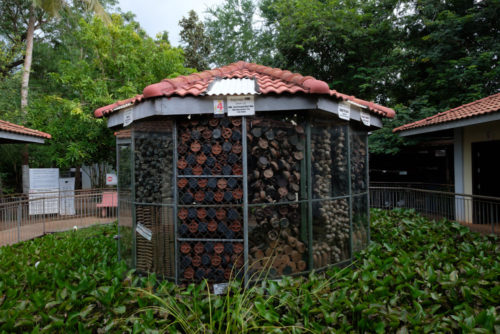
In 1992, after a year spent demining with the UN, a young Aki Ra originally set out on his own with little more than a stick and a pliers to root out and defuse what landmines he could find. He had already succeeded in neutralising 50,000 landmines when, under pressure from the government, he formally trained and qualified as a deminer in the UK. According to one person who knows him well, the young maverick was apparently giving his instructors lessons on how to handle the lethal weapons.
The Museum is associated with CSHD, and also with a school that takes in children who have been victims of landmines, and the derisory $5 entry fee helps to support those undertakings. It is beyond a worthwhile enterprise, and a tour here is always illuminating and engaging.

We returned back to the hotel had a rest for a while before embarking on to the night market for another bout of last minute shopping. It was the last day at Cambodia and the next day we were leaving Siem reap via Malayasia to Kochi. It will be a long 6 hour travel to India. Our journey at Siem Reap was really a very memorable trip.
What was my overall impression. It is tourism all over. Leaving out the great temples of Angkor and surrounding region, almost every street was taken up with surprisingly well appointed restaurants, bars, hotels, souvenir shops, tour operators, internet cafes, massage parlours (both real and fronts for brothels), as if the whole town existed only to serve foreign tourists. I do agree some local people are benefiting from the tourism boom through more and better paying jobs, but most of the wealth from the tourism boom seems to go to foreign business owners.

We spent a week in Siem Reap, much longer than the town’s average visitor. It has more to offer than just a jumping off point for the Angkor temples. Angkor temples were great places of cultural heritage and due to excessive tourism, they too are getting destroyed. I hope they will find a way to manage the tourist inflow and still preserve these great temple ruins for the future.
Thanks to all of you for being part of this journey and encouraging me to write this travelogue. If you have missed earlier, check all the 8 parts with links below.


Very beautifully documented..thanks for sharing. Such intricate & perfect curvings are a pleasure to watch..very nice.